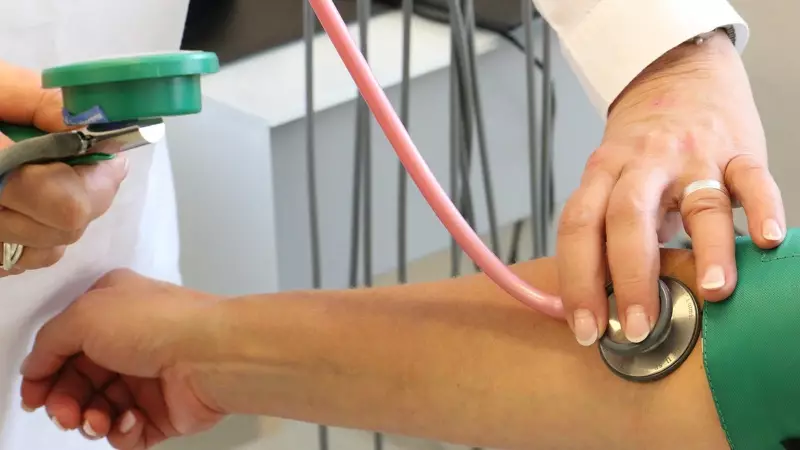
A shocking case of a 17-year-old boy collapsing with dangerously high blood pressure has highlighted a disturbing global trend revealed in a new Lancet study. The teenager was rushed to Poona Hospital after losing consciousness at home, where emergency doctors discovered his blood pressure had skyrocketed to 200/120 mmHg - far above the normal 120/80 mmHg reading.
Hypertensive Crisis in Young Population
The young patient was experiencing a hypertensive crisis, a life-threatening condition where blood pressure surges beyond 180/120 mmHg, potentially causing severe damage to vital organs including the brain, heart, and kidneys. Cardiologists conducted extensive medical tests, checking for serious conditions like aortic tears that typically trigger such extreme BP spikes, but all results came back negative.
Dr Vijay Natarajan, Chief of Cardiac Surgery at Poona Hospital, explained their investigation into the teen's lifestyle revealed the underlying causes. The boy had obesity, was addicted to fast food, noodles, and high salt-sugar-fat foods throughout the day, and maintained a very sedentary lifestyle. He spent excessive time on devices for studying, online gaming, and entertainment, creating a perfect storm for hypertension development that went undetected and unmonitored.
"For the last two years, he has been on anti-hypertensive medication. We worked on his weight issues and diet consistently. Today, he has lost 18 kg and is much fitter," Dr Natarajan reported, highlighting the importance of early intervention and lifestyle changes.
Global Childhood Hypertension Epidemic
This individual case reflects a much larger pattern uncovered by researchers in The Lancet Child and Adolescent Health journal. The comprehensive study reveals that high blood pressure in children and adolescents nearly doubled between 2000 and 2020, now affecting approximately 114 million young people worldwide.
The statistics are particularly alarming: while about 3.2% of children had hypertension in 2000, this prevalence increased to more than 6.2% of children and adolescents under age 19 by 2020. This means the condition now affects nearly one in every sixteen young individuals globally.
Dr Peige Song, study author from Zhejiang University School of Medicine in China, emphasized that while India-specific data isn't available, the country shares many characteristics with other lower-middle-income countries included in the analysis. The WHO South-East Asia Region, which includes India, reported the highest prevalence of isolated diastolic hypertension at 2.77% compared to other global regions.
Key Risk Factors and Regional Concerns
According to Dr Song, this regional pattern likely reflects specific cardiovascular risk factors prevalent in South Asia, including high dietary sodium intake, rising obesity rates, low physical activity levels, and systemic health disparities. The research was funded by the National Natural Science Foundation of China and involved meta-analysis of data from 96 large studies encompassing more than 443,000 children across 21 countries.
Obesity emerges as a particularly significant driver in this health crisis. The study found that nearly 19% of children and adolescents with obesity have hypertension, which is eight times higher than the prevalence among those considered to be at a healthy weight.
Additionally, approximately 8% of young people now have pre-hypertension, serving as a critical warning sign of potential progression to full hypertension. If left unaddressed, this could lead to serious health complications including cardiovascular and kidney disease later in life.
Dr Natarajan identified multiple triggers contributing to this worrying trend. "Obesity, poor dietary choices, sedentary lifestyles, stress at a young age from career goals, irregular sleeping hours and an incapability to handle emotional situations are among the many triggers for hypertension in adolescents," he explained.
Diagnostic Challenges and Screening Improvements
The research team highlighted significant challenges in accurately diagnosing childhood hypertension. How blood pressure is measured in young patients substantially affects prevalence estimates. When hypertension is confirmed by healthcare providers over at least three in-office visits, the prevalence was estimated at approximately 4.3%. However, when researchers included out-of-office assessments like ambulatory or home blood pressure monitoring, the prevalence of sustained hypertension climbed to about 6.7%.
The study also revealed concerning phenomena like masked hypertension, which affects nearly 9.2% of children and adolescents globally and often leads to underdiagnosis. This condition occurs when hypertension isn't detected during routine checkups but is present in other settings.
White-coat hypertension was found to be more prevalent in lower-middle-income countries (8.13%) compared to high-income countries (3.70%), suggesting that a notable proportion of children in LMICs might be misclassified. Dr Song emphasized the need for standardized BP measurement protocols in India to improve diagnostic consistency across healthcare settings.
Call for Action and Prevention Strategies
Professor Igor Rudan, Director of the Centre for Global Health Research at The Usher Institute, University of Edinburgh and study author, stated that these findings should serve as an alarm bell for healthcare providers and caregivers worldwide. However, he offered hope by noting that immediate action can make a significant difference.
"The good news is that we can take steps now, such as improving screening and prevention efforts, to help control high blood pressure in children and reduce the risks of additional health complications in the future," Professor Rudan emphasized.
Dr Natarajan pointed to increasing affordability and easy access to unhealthy foods as major contributors to the childhood obesity epidemic. He described the situation as "a lifestyle healthcare epidemic of unknown proportions" due to insufficient monitoring data.
The medical expert advocated for regular health screening programs at schools and colleges to detect such conditions early and initiate definitive treatment immediately. Such proactive measures could significantly reduce early onset of dangerous complications affecting the heart, brain, and kidneys in later life stages.
As the global community grapples with this growing health challenge, the Lancet study serves as a crucial wake-up call about the importance of monitoring young people's blood pressure and addressing lifestyle factors that contribute to hypertension from an early age.





